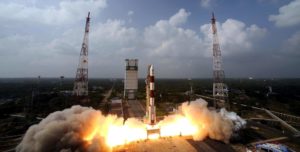
India launched its Mars Orbiter Mission (MOM) with its Polar Satellite Launch Vehicle (PSLV) launcher and everything, including the weather, performed as expected. The 1340KM Mars bound probe with a 15km package of five science instruments will arrive at Mars in December next year.
Currently MOM is in Earth orbit where it will remain for another week. Why? Because the Indian Space Research Organisation (ISRO) is still working on its more powerful launcher the Geosynchronous Launch Vehicle (GSLV) so had to use the less powerful but extremely reliable PSLV. Hence the modest science package and the requirement of six orbits of Earth for gravity assist. Several engine firings on November 6, 7, 8, 9 and 11 are required, each one increasing MOM’s speed. A final burn on 16th November will finally supply it the speed it needs to reach Mars. With another critical engine burn is required for arrival in Martian orbit on 1st of December. If that burn, almost a year from now fails, MOM will fly past Mars and be lost in space.
India’s space program was founded almost 50 years ago on the principle that space technology is an essential instrument for national development. Although commercial, military and scientific elements have since crept in, improving the quality of life for the huge Indian population, remains its primary objective.
ISRO has designated this as a technology demonstrator, India is building on the its Chandryaan-1 mission from 2008 but the engineering and technical challenges are an order of magnitude higher. ISRO was successful in reaching the Moon on its first attempt, it is hoping to do likewise with Mars.
Here is a 4 minute clip of my audio interview on Voice of Russia. I am introduced as a science journalist which of course I am not.
Leave a Reply